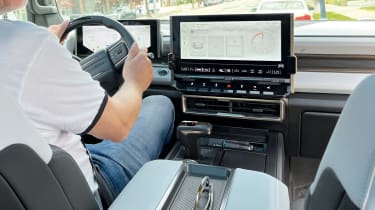GMC Hummer EV review
A vast behemoth that’s far too big and unwieldy for UK streets, the Hummer EV is still an impressive feat of engineering
Pros
- Brutal acceleration
- Off-road ability
- Fast charging
Cons
- Monstrously heavy
- Some cheap materials
- Inefficient
| Car type | Range | Wallbox charge time | Rapid charge time |
|---|---|---|---|
| Electric | 329 miles | 28hrs (0-100%, 7.4kW) | 31mins (10-80%, 300kW) |
The original Hummer was originally developed for military use, with little regard for fuel economy or urban manoeuvrability. Civilian versions proved popular with American buyers keen on excess and, after a few years away, the Hummer name is back. This time, it’s playing toy soldiers and has returned with a fully electric powertrain. Don’t think it’s become a green machine, though.
Electric cars often weigh more than equivalent petrol or diesel cars, but none are as portly as the GMC Hummer EV. It weighs the best part of four-and-a-half tonnes. A good proportion of that (1.3 tonnes) is attributed to the vast 213kWh battery pack, which alone weighs more than a Smart EQ ForFour.
Weight adversely affects many things: handling, braking, efficiency and performance. The Hummer gets around the last of those with the option of a 986bhp triple-motor electric powertrain, like a Tesla Model S Plaid, which is good for a 0-62mph time of just 3.5 seconds if you engage the launch mode called ‘Watts To Freedom’.
While getting up to speed is no problem at all, reigning in all that weight isn’t a pleasant experience. It takes a lot of room to decelerate from motorway speeds, and regular heavy braking will quickly lead to brake fade.
Low-speed driving is actually less of a chore than you might imagine, with four-wheel steering dramatically improving manoeuvrability. Not that you’d want to drive the Hummer EV round a quaint British village, due to its towering dimensions. At higher speeds it’s unwieldy and you’re always aware of its width. Luckily, a range of cameras help out here.
We didn’t get a chance to take it off-road, but this is where the Hummer EV should come good. With a track that’s almost as wide as the original Hummer H1, the new car has the same party trick of being able to follow tank tracks. Optional air suspension should be a boon on rocky trails, while the four-wheel steering even allows diagonal crab-like driving. How useful any of this’ll be on city streets remains to be seen.
It’d probably have the measure of its main rivals – the Rivian R1T and Ford F-150 Lightning – on rough terrain, but those trucks are better at practical, truck things. The Hummer trails the competition on payload, load-bed size and towing capacity. That may not matter a jot to Hummer buyers, mind, as the majority are probably planning to use it as a lifestyle vehicle rather than a true workhorse.
After all, buyers focused on pure utility are unlikely to spend around $100,000 (approximately £85,000) on a work vehicle. Regardless, it seems that the majority of that cost is down to the whopping battery pack and the monstrous powertrain, because material quality inside is rather disappointing in places.
Sure, you can take the roof off and the mechanism and parts for that are impressive, but a lot of the cabin plastics feel too cheap for a car costing this much. As a convertible, the loadbay basically becomes a space to store the roof. Though there is a handy 320 litres of additional storage space under the bonnet.
There are a lot of standard features, including a 13.4-inch central touchscreen and 12.3-inch digital driver’s display, plus GMC’s SuperCruise semi-autonomous driving tech. The graphics come from the same company that makes video games such as Fortnite, although there is some lag, which is hard to justify at this price point.
The Hummer boasts an official range of 329 miles, which is reasonable (until you consider how large the battery is). In reality, you should get close to 300; our test car had 75% charge and a 229-mile range estimate. Efficiency was around the 1.5 miles per kWh mark, so the Hummer will still cost a lot to run even with electric power.
Like the Porsche Taycan, the Hummer uses 800-volt technology for charging speeds of up to 300kW; find a compatible rapid charger and nearly 100 miles of range can be added in 10 minutes (on the sold-out Edition 1). It’ll take a long time to recharge the Hummer on a less powerful charger – as much as a day-and-a-half on a 7kW home wallbox.







